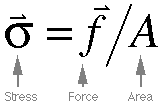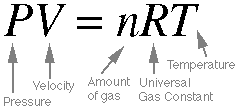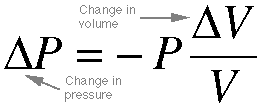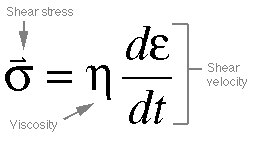Chapter 2: Biomechanics of Laryngeal Tissue

Equation 2.1. This equation defines velocity,
which is a vector quantity, as change in displacement over change in
time. Vector quantities are made of two
or more independent pieces of information. For instance, velocity consists
of a speed and a direction. Vector quantities in our equations are written
with arrows over them to distinguish them from scalar quantities,
which consist of only one piece of
information.

Equation 2.2. Momentum, also a vector quantity,
consists of the mass multiplied by the velocity vector. The product is a
new vector which measures the potential force (thus the symbol p)
when colliding with another object.

Equation 2.3. Force is defined as the rate of change
of momentum over time. Since momentum is made up of mass and velocity, a
change in either can change momentum. For our purposes, however, mass usually
does not change (the mass of the vocal fold remains constant), and so momentum
becomes the product of the constant mass and the rate of change in velocity.
This produces:

Equation 2.4. This equation has been rewritten to
show mass as a static quantity.

Equation 2.5. Acceleration, also a vector quantity,
is the rate of change in velocity over time.

Equation 2.6. If we replace the dv/dt from
equation 2.4 with a (equation 2.5 allows us to do this), we
arrive at the equation above, which is Newton's Second Law: force equals
mass times acceleration.

Equation 2.7. Stress, which measures the intensity
of a force distributed over a region, is defined as force divided
by unit area. This explains why sharp objects can penetrate a hard
barrier more easily than dull objects with the same force, because the force
is distributed over a smaller area and is thus magnified.

Equation 2.8. Strain is a measure the elongation
in a medium resulting from stress being applied to it. It consists of the
difference between the original (rest) length and the new (compressed or
elongated) length, divided by the orginal length. Strain is someti mes expressed
as a percentage (a strain of 0.2 expressed as a 20% elongation, for instance),
since it is usually less than 1.0.

Equation 2.9: Hooke's Law. This law states that stress
is proportional to strain. So, any change in one variable will result in
a proportional change in the other variable. A doubling of one will
result in a doubling of the other, and so forth. E in the equation
above is a constant called Young's modulus, or the modulus of
elasticity.

Equation 2.10. This equation describes the behavior
of ideal gases. For voice production, the very small pressure differences
we create with our voices are the variables to concentrate on. Since the
right side of the equation above can be reduced to all constants if we assume
a constant temperature, we can use the left side to relate pressure directly
to volume, as given in the next equation:

Equation 2.11. The change in volume (delta-V) divided
by the unstressed volume V gives us the volumetric strain EPSILON,
just as in Equation 2.8 above. This equation can also be written plainly
as PV = constant; see Equation 3.1.

Equation 2.12. This equation governs fluid flow. For
a given stress being applied, the larger the viscosity is, the longer it
will take for deformation to take place. So, a fluid like molasses would
have a rather high viscosity, whereas water or alcohol flow quite freel y
and have low viscosities.
Equations
Homepage Chapter
3 Equations
|



